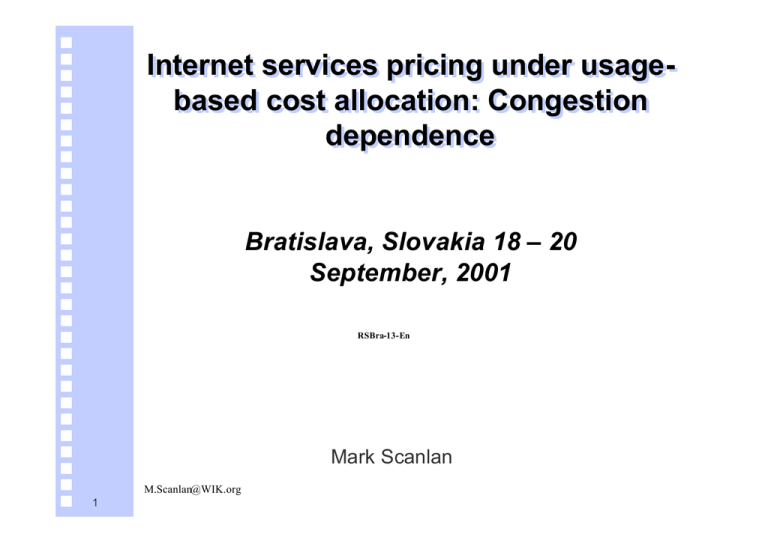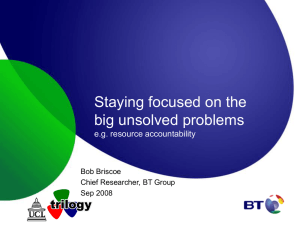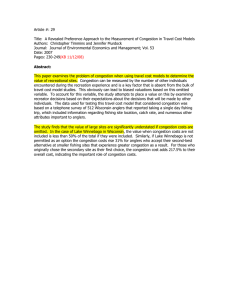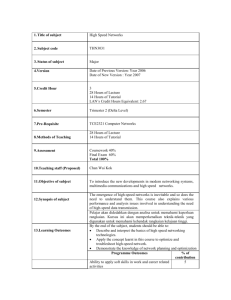Internet services pricing under usage- based cost allocation: Congestion dependence
advertisement

Internet services pricing under usagebased cost allocation: Congestion dependence Bratislava, Slovakia 18 – 20 September, 2001 RSBra-13-En Mark Scanlan M.Scanlan@WIK.org 1 Issues addressed in this presentation 2 u QoS and congestion management u Real-time services u Matching price structures with cost causation u Technical mechanisms to improve QoS u Future fragmentation in standards, and industry structure ? u Network externalities No. Packets Time 3 Price per packet Demand Supply Quantity of packets 4 QoS and congestion management u QoS on the internet is essentially statistical: Ø u 5 Latency, jitter, bandwidth, packet loss, availability. All packets treated the same, but ‘real-time’ service packets require different QoS. Ø Real time service not yet viable on the public internet. Ø As well as for technology reasons, one of the main causes of this is that economically efficient pricing structures are not used. Existing congestion management 6 u Over-provisioning has been the principle means ISPs have used in meeting peaks in demand. u ISPs accept traffic on a ‘best-effort’ basis, although increasingly QoS statistics are contracted. u Congestion management / resource optimisation is treated as a technical issue Congestion management Ø TCP – Little account of order and timing – queuing results in overflow indicating congestion to sending TCPs and a slow down in packet sending. Ø u u 7 ATM – traffic shapping Presently backbone congestion is hidden within: Ø Overall round trip times and system start-up latency, and Ø Delays between the backbone and end-user. Broadband access will help bring backbone congestion into focus. Congestion management u Prices provide the efficient means for managing congestion. u Presently, dial-up users are charged: Ø by their access provider – per minute (EU); Zero - DLS, USA, NZ; 25 cents (Aust) Ø u Price signals are passed from the parameter up through the loose hierarchy Ø 8 per month by their ISP No congestion pricing with ISP interconnection Congestion management u Increasingly flat-rate pricing is the end-user ISP model - extra packets are not priced. u To be economically efficient the structure of prices should match the structure of costs. u There are 3 types of cost involved that should ideally be mirrored in the prices charged to users. 1. fixed costs (these don’t vary with usage). 2. initial cost of connecting a customer to the internet 3. congestion cost 9 Congestion management u Assuming a technology solution would have been found, one of the costs implied by the existing price structure concerns the absence of the market for real-time services. u For economic efficiency the price structure should have all 3 components: 1. A subscription charge – These costs can not be said to be incremental to any single customer. – No person should be charged a subscription more than their willingness to pay. 2. A one-off charge, and 3. A congestion charge. 10 Congestion management 11 u Web-sites are the main senders of traffic - not end-users. u Fixed costs (1) should be shared between W S and end-users, given network effects. u Does not alter the need for congestion pricing, but does complicate it. Congestion management u The congestion charge – should not apply when the network is uncongested – should equal the margin cost of delay if existing capacity is optimal. – If a price higher than this can be charged, and the network still becomes congested, it indicates a profitable opportunity to increase capacity. 12 u On the PSTN congestion pricing is charged during a time-of-day. u Not practical for the internet due to congestion periods being unpredictable. Alternative is some form of spot market. Congestion management u u 13 real-time Vickrey auction has been proposed Ø All users admitted to the internet during this period would pay the bid price of the marginal user. Ø This would be zero at uncongested periods Ø Where there is insufficient capacity, it will provide a price that will signal that an increase in capacity is profitable (required). Not practical as packets can not be accounted for presently. Future congestion management 14 u MM-V provide an intellectual basis behind research for a practical solution. u IntServ is designed to allow control of end-toend QoS per data flow. u Enables QoS statistics to be raised to several levels, thus making it possible for real-time applications to run on the internet. u Option that appears more suitable for realtime service requires estimates of the demands required by users so that resources are available. Future congestion management u Problems: – RSVP has poor scalability – IntServ requires a basic feedback mechanism to prevent network resources being cornered - not addressed by designers. – Complexity of the IntServ RSVP model is means it is not considered the way forward for the public internet. u 15 DiffServ requires users wanting higher QoS to define their service profile, with tagged packets needing to fit this profile Future congestion management u Traffic controls : – – – – 16 Occur at admission traffic is scheduled according to customer profile traffic is sorted for different treatment network resources need to be allocated u Sorting, profiling, metering, happen at the boundaries between networks, where packets tags are addressed in aggregate - scalable 3 u Needs IPv6 to operate u No guarantees - requires QoS contracting and verification between ISPs. QoS and standards co-ordination 17 u Strategic interests of 1 (or more) leading IBPs may be to differentiate itself by offering new services on-net only. u If this was likely to occur, vertical and some horizontal integration may well occur. u In a growing market where indirect network effects are strong, the incentive to co-operate with standards may counter incentive of IBPs to differentiate themselves. Conclusions u The internet is edging toward becoming an integrated services network Ø 18 e-mail; File Transfer Protocol (FTP); WWW; VoIP; Video. u Lack of efficient pricing structure running through the internet is delaying the development of ‘real-time’ services. u Ongoing technology developments are occurring, but economic issues need to be addressed. Conclusions u Arguably the main problem will be in securing similar QoS for traffic going off-net. Ø 19 Accounting systems that provide ISPs with transparency will need to be developed. u Strategic interests of 1 or more IBPs may result in (vertical) agreements, vertical mergers, and real-time services only being provided on-net . u Email, WWW, FTP would still be universally provided. But new products might be on-net only.



